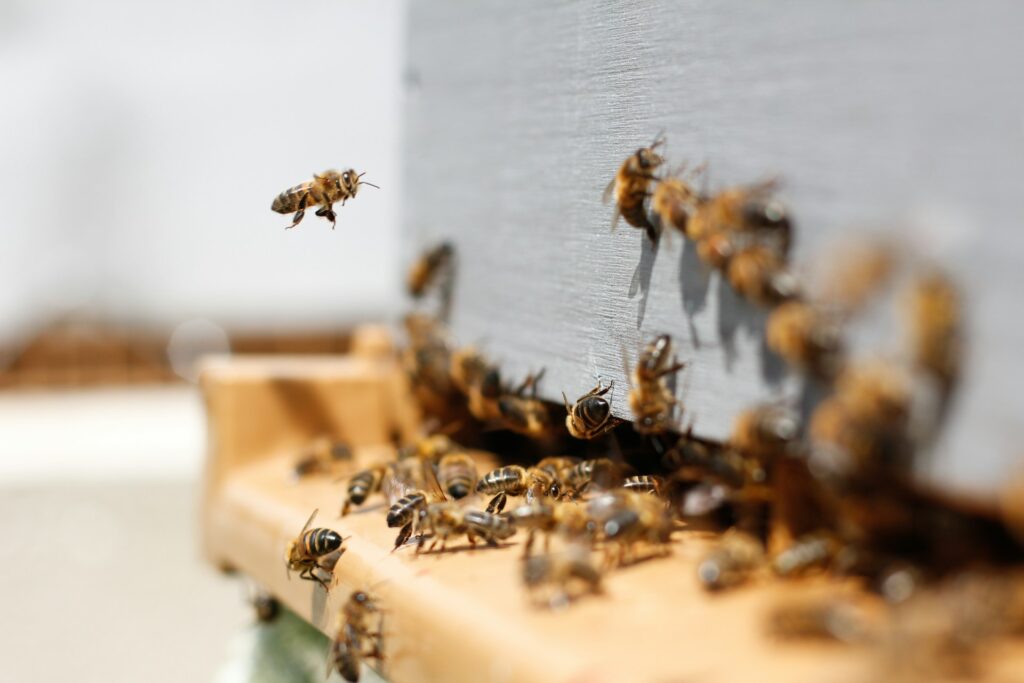Finding a beehive near your home can be both alarming and confusing. Pollination and the general well-being of the ecology are two areas in which bees are essential. On the other, a hive too close to your living space can present real risks. Whether you’re concerned about the safety of your family or wondering how to handle the situation without harming the bees, it’s important to take the right steps.
This guide will walk you through the do’s and don’ts of dealing with a nearby hive, how to protect yourself, and when it’s time to call in professionals.

The Risks of Having a Beehive Near Your Home
Before taking any action, it’s important to understand the potential dangers that come with having a beehive too close for comfort.
Increased Risk of Stings for Family and Pets
Generally speaking, bees do not sting unless they are threatened. However, a hive located near doors, patios, or children’s play areas can increase the chances of accidental encounters. This can be particularly dangerous for people with bee sting allergies, where even a single sting can cause severe reactions like anaphylaxis. Pets can also become targets if they accidentally disturb the hive.
Structural Damage and Nesting Issues
Often searching for protected locations to establish their colonies are bees. Wall cavities, chimneys, and attics provide the perfect nesting spots. Over time, the hive can cause damage to insulation, wiring, and walls. Furthermore, other insects, rodents, and bees might be attracted to honey and wax. Ignoring this might result in expensive repairs down the road.
Swarming and Aggressive Behavior
While swarming bees are usually not aggressive, the sight can be unsettling. If a hive feels threatened, however, its inhabitants may become defensive. Large numbers of bees acting protectively can escalate a situation quickly, leading to multiple stings and heightened danger for anyone nearby.
Immediate Steps to Take Upon Discovering a Beehive
If you spot a hive near your home, remain calm and follow these initial precautions.
Assess the Situation Safely
First and foremost, keep your distance. Sudden movements, loud noises, or attempts to disturb the hive can provoke defensive behavior. Observe from afar to determine the size and location of the hive without putting yourself at risk.
Identify the Type of Bees (or Insects)
Not all stinging insects are classified as bees. Wasps and hornets can be more aggressive and present distinct challenges. If you’re unsure whether you’re dealing with honeybees or other insects, take a photo from a safe distance and consult a professional.
Do’s and Don’ts When Dealing with Beehives
What NOT to Do
Although it may be tempting to solve the issue on your own, doing so often makes matters worse. Do not attempt to spray the hive with insecticides or hose it down with water. These methods not only fail to address the root problem but can also agitate the bees and create a dangerous situation. Blocking the hive entrance without removing its occupants can also lead to bees finding their way into your home’s interior.
What You SHOULD Do
The safest course of action is to contact a professional bee nest removal service or a local beekeeper. These professionals can move the hive securely without endangering your family or the bees. Keep the area clear of foot traffic, and if anyone in your home has severe bee sting allergies, consider leaving the area until the hive is dealt with.
Preventive Measures to Deter Future Beehives
Once the hive is removed, or if you want to prevent bees from settling near your home in the first place, these proactive steps can help.
Seal Up Potential Nesting Sites
Inspect your home regularly for small openings, especially in attics, walls, and vents. Close up any openings or crevices that bees could utilize to enter and build their nests. Installing screens over vents and chimneys is another effective deterrent.
Yard Maintenance and Landscaping Tips
Potential hive sites may be decreased by routinely pruning trees and bushes close to your home. While it’s great to plant flowers for pollinators, avoid placing them directly next to your home’s entry points. Secure trash bins as they can attract other pests that may, in turn, attract bees.
When to Seek Professional Help
Signs You Need Immediate Assistance
If you notice aggressive bee behavior, repeated swarming, or the hive is located in a high-traffic area, it’s time to call for help. Additionally, hives inside your home’s walls or attic require expert removal to prevent further structural damage.
Understanding Legal Protections for Bees
Honey bees are legally protected in several places. It could be against the law to try to eradicate them. A certified bee nest removal specialist will understand local regulations and ensure the hive is handled ethically.
The Right Approach to Beehives Can Make All the Difference
It might be unsettling to see a beehive next to your house, but you can safeguard the bees and your family by taking the appropriate precautions. Avoid DIY removal and focus on stinging insect safety by calling professionals who specialize in humane and effective bee nest removal. Remember, while bees can pose risks, they’re also critical to our environment. Taking careful, informed steps ensures a safe solution for everyone involved.
Expert assistance from SC Pest Solutions is available to safeguard your family and residence. Our professional team specializes in safe, humane bee nest removal and ensures top-notch stinging insect safety. Don’t take risks—call SC Pest Solutions today for fast, reliable service and peace of mind. Your safety is our priority!
